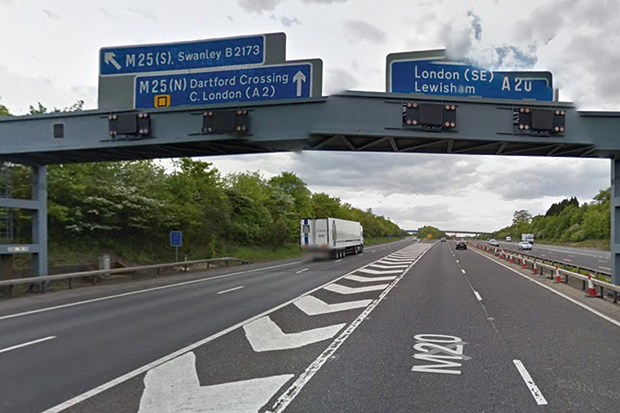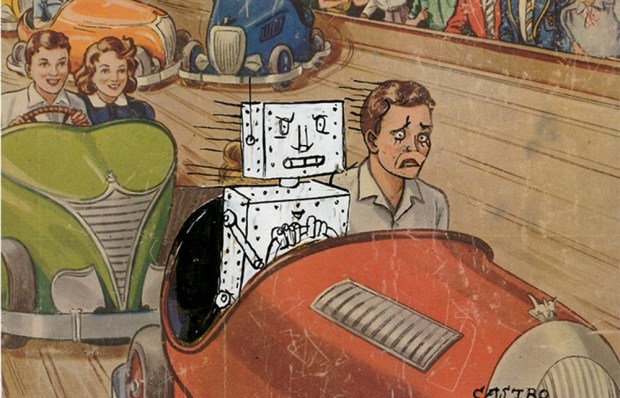Driving from Dover on the M20 a year ago I missed the turning for the M25. A month later I did it again. Then again. ‘You bloody idiot — you missed the turning,’ I said to myself each time. Eventually, after I had missed the turning five times in ten journeys, I wondered if it was really all my fault. So I logged on to Google Street View and retraced the stretch of the M20 leading up to the junction. That’s when I found the image below.
Perhaps it doesn’t look odd to you. It took me a while to spot why it is a contender for the world’s worst road sign. By the time you can read the information it contains, you can no longer act on it. Some idiot has painted a row of chevrons in the road for the previous 500 yards (which it is illegal to cross). So the sign announces your lane too late for you to do anything about it. As Bob Dylan explains in ‘Brownsville Girl’ (though he is possibly not referring to the M20), ‘I’ve always been the kind of person that doesn’t like to trespass/ but sometimes you just find yourself over the line.’
What fascinates me is what this mistake reveals about human decision-making. A higher intelligence might notice immediately that the sign is in the wrong place; we don’t. When presented with inadequate or untimely information we are oblivious to its limitations; instead we make do with whatever inadequate information is available and carry on.

Major decisions in life — where to buy a house, for instance — are made by rapidly comparing at most two or three options. We are blind to the narrowness of our search and unconscious of any pertinent information we lack. Daniel Kahneman calls this phenomenon WYSIATI — ‘What You See Is All There Is.’
So for decades, when faced with a patient with tonsillitis, GPs assumed they had a simple choice: either a) prescribe antibiotics or b) don’t. Only recently did anyone realise there is another option: you can issue a post-dated prescription for antibiotics. ‘If you aren’t feeling better by Friday, take this to the chemist.’ Almost all patients given an immediate prescription will take antibiotics, and often unnecessarily; this proportion drops to around 35 per cent in the case of a deferred prescription. I’m not saying the third option is perfect — but it helps to know it exists. For decades it seems nobody did.
Recently there can be no better example of WYSIATI in action than the reams of journalistic guff written about the Clarkson incident — where at most six people on earth really know what happened. Deborah Orr even wrote an article in the Guardian which began with the words ‘Details of the fracas are as yet sketchy…’ and ended with ‘Clarkson should do the decent thing, and resign.’
However, the BBC — which presumably does know what happened — has also failed in its decision-making. Faced with an incident of this kind, there is only one decision you can make: a quick one. You can encourage the two people to make up over a pint, or you can fire someone; either decision is perfectly fine so long as you make it fast. Often the likelihood that people will respect a decision is proportional to the speed at which you make it.
Got something to add? Join the discussion and comment below.
Get 10 issues for just $10
Subscribe to The Spectator Australia today for the next 10 magazine issues, plus full online access, for just $10.
Rory Sutherland is vice-chairman of Ogilvy Group UK.
You might disagree with half of it, but you’ll enjoy reading all of it. Try your first month for free, then just $2 a week for the remainder of your first year.














Comments
Don't miss out
Join the conversation with other Spectator Australia readers. Subscribe to leave a comment.
SUBSCRIBEAlready a subscriber? Log in